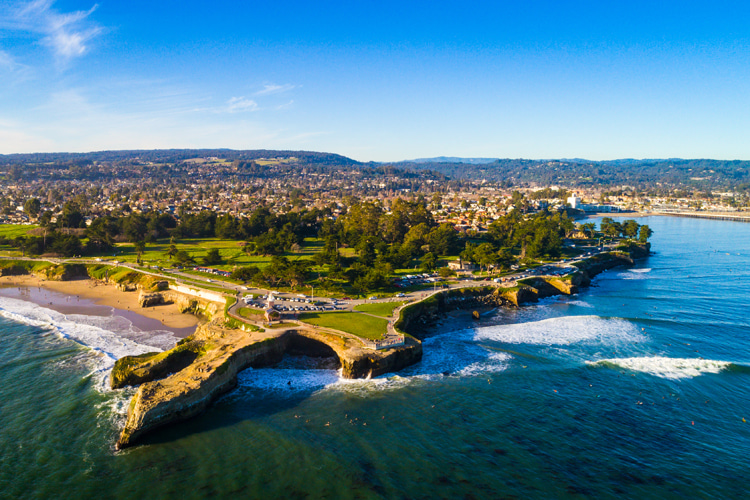Steamer Lane is one of the most iconic surf spots in California and has been the epicenter of the Santa Cruz surf scene since the 1930s.
Tucked into the northern part of Monterey Bay, a crescent-shaped cove located northwest of the fertile Salinas Valley, is the town of Santa Cruz.
It is known for its generally mild, Mediterranean-like climate, laid-back lifestyle, excellent surfing, well-developed marine terraces, and beautiful coastline.
The renowned cold water reef/point break is located off a point in West Cliff Drive, two miles south of downtown Santa Cruz and 75 miles (120 kilometers) south of San Francisco.
The Santa Cruz Surfing Museum, established in May 1986 at the base of the Mark Abbott Memorial Lighthouse, has a privileged view of the legendary Northern California wave.
But why is it called Steamer Lane?
There are two similar theories, and they both refer to the presence of steamships that used to cruise in the local marble-green waters.
They came from the north and would have to steer clear of the large surf in the area before they turned into Monterey Bay.
One of the hypotheses indicates that in the late 1930s, two friends - Claude Horan and Wes Hammond - thought it would be nice to hire steam-powered boats to cruise back and forth to create surfable waves in the region.
Hence, they named it Steamer Lane.
The other theory states that in the 1930s, surfers started calling the spot Steamer Lane because of the big waves that broke out at Third Reef in the nearby steamship lane.
If you're visiting Santa Cruz and plan to surf its famed surf break, remember one thing - don't call it "Steamers."
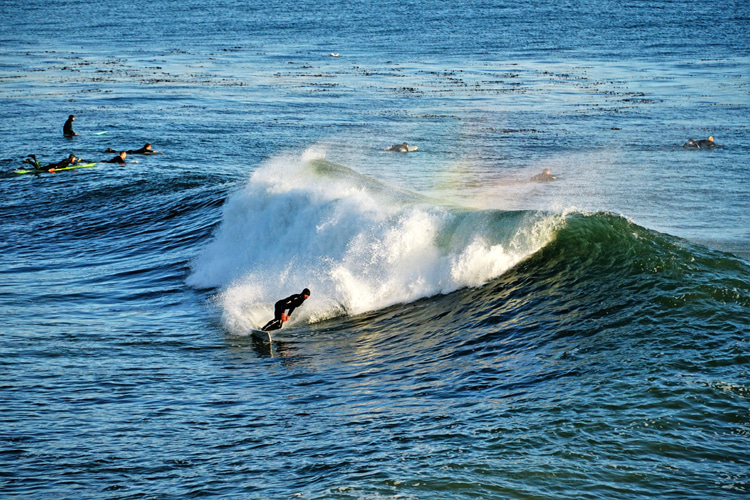
The Birthplace of Surfing in Mainland America
It's important to stress that the Monterey Bay area is the birthplace of surfing in mainland America.
In 1885, three young Hawaiian princes rode waves off the San Lorenzo River mouth.
Jonah Kuhio Kalaniana'ole and his brothers David Kawananakoa and Edward Keli'iahonui, nephews of Queen Kapi'olani, were the first to surf in California.
They were attending St. Matthew's Hall Military School and paddled out in the region with homemade redwood plank boards purchased at the Grover Brothers Mill.
Between 1885 and the 1890s, a small group of surfing enthusiasts continued the board-riding legacy along the town's southern beaches.
But the sport only really took off after Duke Kahanamoku's surfing exhibition in 1938.
That same year, Bill Grace, Buster Stewart, Harry Mayo, and other high school students founded the Santa Cruz Surfing Club.
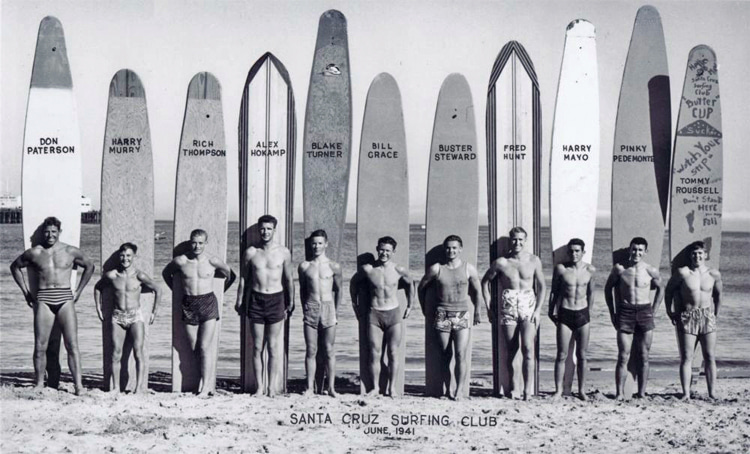
The Jack O'Neill Era
In the 1950s, Steamer Lane was considered one of the best training arenas for Makaha, the famous and thunderous Hawaiian surf break located on the North Shore of Oahu.
The first surfers to tame the big waves of Santa Cruz were Peter Cole, Ricky Grigg, and the Van Dyke brothers.
They rode heavy and leashless wooden surfboards in cold, shark-infested waters without wetsuits and several decades before Mavericks' golden epoch.
These unsuitable conditions would change in 1959 when surfer and entrepreneur Jack O'Neill relocated his business from San Francisco to Santa Cruz.
O'Neill opened a surf shop at Cowell's Beach and began experimenting with neoprene wetsuits.
Initially, only local surfers had access to these second skins.
In the 1960s, Santa Cruz had a flourishing and tight surfing community with Danny Anderson, Doug Haut (co-founder of NHS and Santa Cruz Skateboards), Gene Hall, Gary Venturini, and Rod Lundquist as some of the top performers.
"In the 1961 surf movie 'Angry Sea,' you can already see Jim Foley riding a 7'10'' surfboard, seven years before the shortboard revolution," notes Matt Warshaw, author of "The Encyclopedia of Surfing."
A decade later, Pat O'Neill and Roger Adams introduced a revolutionary piece of equipment - the surf leash.
The reason was simple. O'Neill got tired of losing his board into the cliffs at Steamer Lane - something had to be done to solve this problem.
Before the leg rope era, the spot was often a surfboard cemetery, with dozens of lost and broken boards floating around.
At the time, the leash was considered a controversial product.
Pat O'Neill called it a "shot cord." It featured a suction cup fixed to the deck of the board just below the nose.
Then, attached was a flexible six-foot surgical tubing that looped around a surfer's wrist. Can you imagine that?
According to Dan Young, founding chairperson of the Santa Cruz Surfing Museum and co-founder of the Surfrider Foundation, the innovation had been initially developed by Santa Cruz kneeboarder Jack White.
The O'Neill family bought the rights from White and spread the leash within the surfing community.
"Purists were disgusted. A wipeout was something you paid for, the reasoning went, with a swim to the beach and maybe even a damaged board," adds Warshaw in "The History of Surfing."
But the surf leash proved to be extremely useful. And it stuck.
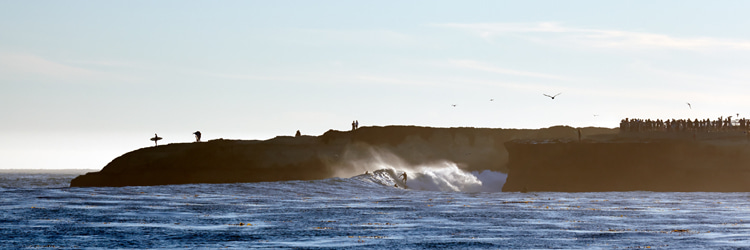
Localism and Surf Contests
The popularity of Steamer Lane as one of the go-to big and high-performance waves in California also increased localism.
"In 1969, before the start of a contest, a group of Santa Cruz surfers pushed the judges' scaffolding off the cliff at Steamer Lane," recalls the surf historian.
"The following day, they refused to give away to the competitors in the water, yelling to the visitors that they were 'goose-stepping pigs.'"
However, from the early 1960s onward, several surf competitions got underway at the legendary Northern California reef break.
The Santa Cruz Pro-Am, the O'Neill Coldwater Classic, the Yeah Now No-Cord Classic, and the Big Stick Surf-o-Rama were the most memorable events held in town.
Between the 1980s and the 2000s, Steamer Lane produced new stars, including Adam Repogle, Chris Gallagher, Richard Schmidt, Vince Collier, Peter Mel, Shawn Barron, Darry "Flea" Virostko, Anthony Tashnick, Josh Loya, Ken "Skindog" Collins, Jay Moriarity, etc.
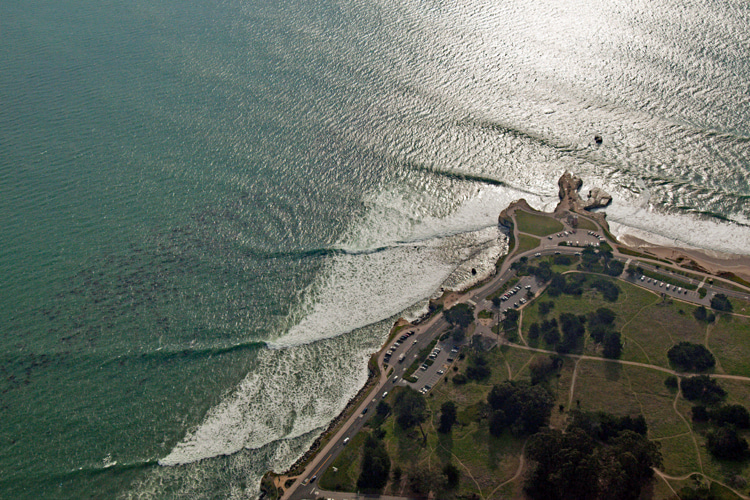
Steamer Lane: The Four Peaks
Steamer Lane comprises four overlapping peaks. They are some of the most crowded and competitive take-off zones in California.
Each one of these waves has its own mood and characteristics and is extremely sensitive to tide changes, swell windows, and winds.
One of the fastest - yet most dangerous - ways to get to the lineup is by jumping off the 30-foot cliff near Lighthouse Point Park.
1. The Point
The Point is a shifty right-hand wave that breaks furthest on the outside, at the tip of Lighthouse Point.
With good south or southwest swell, it delivers perfect, hollow, and thick four-to-six-foot right-hand waves.
The take-off is small and can be tricky as it occurs where the wave crashes against a jutting rock point.
2. The Slot
The Slot is a wedgy right-hand wave located a few dozen yards north of The Point.
This fast, high-performance peak favors a west or northwest swell and lower tides.
It provides a few tube riding and aerial surfing opportunities but also a few unexpected pounding closeouts.
3. The Middle Peak
The Middle Peak is a mushy A-frame wave that breaks further into Monterey Bay and shines during larger southwest swells.
The area features a series of reefs that project out more than a mile into the ocean.
Therefore, it is subdivided into the First, Second, and Third Reefs, with each working best at different sizes.
Expect heavy elevator drops followed by easy-to-ride shoulders.
4. Indicators
Indicators is the fourth and last northern peak and can provide 300-yard-long fast rides that could only end at Cowell's Beach.
This hollow hotdog wave is seldom crowded.
It works best with five-to-eight-foot north or northwest swells and medium-to-low tide.
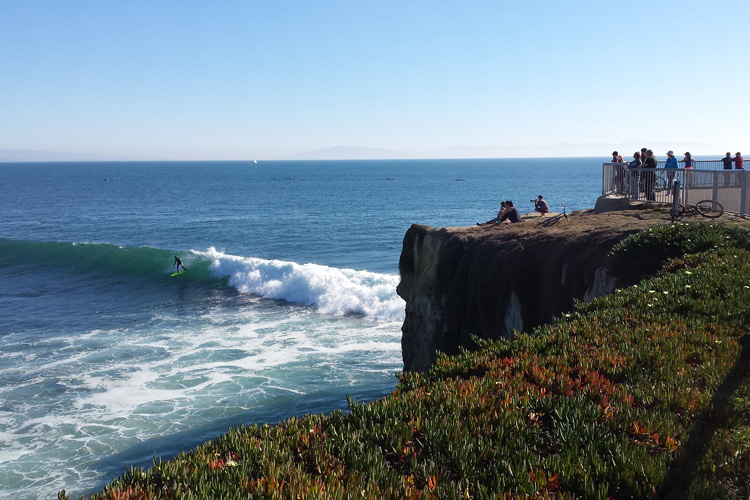
A Spectator-Friendly NorCal Surf Break
Today, Steamer Lane is always crowded, especially during large swells.
Along with Nazaré's Praia do Norte, it is one of the finest and most spectator-friendly surf breaks in the world.
Onlookers gather on the waterfront cliffs to watch the surfers, longboarders, bodyboarders, and even kayakers taking off, dropping in, and showing off their skills in the cold waters.
But the famed surfing hub is one of the 11 spots available within city limits and one of the over 65 breaks that can be found in Santa Cruz County.
Waves tend to be progressively smaller from north to south, but the area is known for providing good surf all year round.
The most consistent time of the year is from late fall to late winter.
Fog, sharks, and thick kelp beds are three relatively common variables that should be taken into consideration if you plan a surf trip to Santa Cruz.
The four Steamer Lane surf breaks are protected from the northwest winds, keeping the waves clean and glassy.
Actually, Lighthouse Point turns northwest winds into offshore winds.
During winter, surfers put on their thickest wetsuits, as temperatures range from 48 °F (8 °C) to 65 °F (18°C).
Steamer Lane loves nearly all swell windows - southwest, west, northwest. You name it.
This is due to the storms generated by low-pressure systems tracking across the North Pacific, the hurricanes spinning off the coast of Mexico in August and September, and the long-range southwest groundswells arriving from the South Pacific.
Nevertheless, ideally, pay attention to a six-foot west swell, with offshore winds coming straight out of the valley at medium tide.
Steamer Lane is arguably Santa Cruz County's best and most famous surf break, even though Pleasure Point and Cowell's Beach are also quite popular.
It's Northern California's ultimate cold-water proving ground.
For years, Santa Cruz and Huntington Beach battled in court for the exclusive rights to use the title "Surf City USA."
At the end of the long legal dispute, the Southern California surf town earned the right to adopt the commercial designation.
Steamer Lane is part of the Monterey Bay National Marine Sanctuary.
